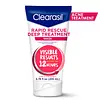What's inside
What's inside
 Key Ingredients
Key Ingredients

 Benefits
Benefits

 Concerns
Concerns

 Ingredients Side-by-side
Ingredients Side-by-side

Salicylic Acid 2%
MaskingWater
Skin ConditioningSodium Cocoyl Isethionate
CleansingCetearyl Alcohol
EmollientGlycerin
HumectantSodium Laureth Sulfate
CleansingSodium Cocoamphoacetate
CleansingCocamidopropyl Betaine
CleansingSodium Hydroxide
BufferingAcrylates/C10-30 Alkyl Acrylate Crosspolymer
Emulsion StabilisingParfum
MaskingDisodium EDTA
Lavandula Stoechas Extract
MaskingHelichrysum Italicum Extract
AntiseborrhoeicCistus Monspeliensis Extract
MaskingSalicylic Acid 2%, Water, Sodium Cocoyl Isethionate, Cetearyl Alcohol, Glycerin, Sodium Laureth Sulfate, Sodium Cocoamphoacetate, Cocamidopropyl Betaine, Sodium Hydroxide, Acrylates/C10-30 Alkyl Acrylate Crosspolymer, Parfum, Disodium EDTA, Lavandula Stoechas Extract, Helichrysum Italicum Extract, Cistus Monspeliensis Extract
Salicylic Acid 2%
MaskingWater
Skin ConditioningPPG-15 Stearyl Ether
EmollientHydrated Silica
AbrasiveGlycerin
HumectantStearyl Alcohol
EmollientCetyl Betaine
CleansingDistearyldimonium Chloride
Sodium Lauryl Sulfate
CleansingCetyl Alcohol
EmollientAlcohol Denat.
AntimicrobialSteareth-21
CleansingSodium Chloride
MaskingBehenyl Alcohol
EmollientSynthetic Wax
AbrasiveSteareth-2
EmulsifyingXanthan Gum
EmulsifyingParfum
MaskingMek
PerfumingDisodium EDTA
Isopropyl Alcohol
SolventBHT
AntioxidantLavandula Stoechas Extract
MaskingMethylchloroisothiazolinone
PreservativeHelichrysum Italicum Extract
AntiseborrhoeicMethylisothiazolinone
PreservativeCistus Monspeliensis Extract
MaskingMica
Cosmetic ColorantCI 77510
Cosmetic ColorantTitanium Dioxide
Cosmetic ColorantBlue 1 Lake
Cosmetic ColorantSalicylic Acid 2%, Water, PPG-15 Stearyl Ether, Hydrated Silica, Glycerin, Stearyl Alcohol, Cetyl Betaine, Distearyldimonium Chloride, Sodium Lauryl Sulfate, Cetyl Alcohol, Alcohol Denat., Steareth-21, Sodium Chloride, Behenyl Alcohol, Synthetic Wax, Steareth-2, Xanthan Gum, Parfum, Mek, Disodium EDTA, Isopropyl Alcohol, BHT, Lavandula Stoechas Extract, Methylchloroisothiazolinone, Helichrysum Italicum Extract, Methylisothiazolinone, Cistus Monspeliensis Extract, Mica, CI 77510, Titanium Dioxide, Blue 1 Lake
Ingredients Explained
These ingredients are found in both products.
Ingredients higher up in an ingredient list are typically present in a larger amount.
We don't have a description for Cistus Monspeliensis Extract yet.
Disodium EDTA plays a role in making products more stable by aiding other preservatives.
It is a chelating agent, meaning it neutralizes metal ions that may be found in a product.
Disodium EDTA is a salt of edetic acid and is found to be safe in cosmetic ingredients.
Learn more about Disodium EDTAGlycerin is already naturally found in your skin. It helps moisturize and protect your skin.
A study from 2016 found glycerin to be more effective as a humectant than AHAs and hyaluronic acid.
As a humectant, it helps the skin stay hydrated by pulling moisture to your skin. The low molecular weight of glycerin allows it to pull moisture into the deeper layers of your skin.
Hydrated skin improves your skin barrier; Your skin barrier helps protect against irritants and bacteria.
Glycerin has also been found to have antimicrobial and antiviral properties. Due to these properties, glycerin is often used in wound and burn treatments.
In cosmetics, glycerin is usually derived from plants such as soybean or palm. However, it can also be sourced from animals, such as tallow or animal fat.
This ingredient is organic, colorless, odorless, and non-toxic.
Glycerin is the name for this ingredient in American English. British English uses Glycerol/Glycerine.
Learn more about GlycerinWe don't have a description for Helichrysum Italicum Extract yet.
We don't have a description for Lavandula Stoechas Extract yet.
Parfum is a catch-all term for an ingredient or more that is used to give a scent to products.
Also called "fragrance", this ingredient can be a blend of hundreds of chemicals or plant oils. This means every product with "fragrance" or "parfum" in the ingredients list is a different mixture.
For instance, Habanolide is a proprietary trade name for a specific aroma chemical. When used as a fragrance ingredient in cosmetics, most aroma chemicals fall under the broad labeling category of “FRAGRANCE” or “PARFUM” according to EU and US regulations.
The term 'parfum' or 'fragrance' is not regulated in many countries. In many cases, it is up to the brand to define this term.
For instance, many brands choose to label themselves as "fragrance-free" because they are not using synthetic fragrances. However, their products may still contain ingredients such as essential oils that are considered a fragrance by INCI standards.
One example is Calendula flower extract. Calendula is an essential oil that still imparts a scent or 'fragrance'.
Depending on the blend, the ingredients in the mixture can cause allergies and sensitivities on the skin. Some ingredients that are known EU allergens include linalool and citronellol.
Parfum can also be used to mask or cover an unpleasant scent.
The bottom line is: not all fragrances/parfum/ingredients are created equally. If you are worried about fragrances, we recommend taking a closer look at an ingredient. And of course, we always recommend speaking with a professional.
Learn more about ParfumSalicylic Acid (also known as beta hydroxy acid or BHA) is a well-known ingredient for treating skin that struggles with acne and clogged pores. It exfoliates both the skin's surface and deep within the pores to help clear out buildup, control oil, and reduce inflammation.
Unlike AHAs (alpha hydroxy acids), salicylic acid is oil-soluble. This allows it to penetrate into pores which makes it especially effective for treating blackheads and preventing future breakouts.
Salicylic acid is also known for its soothing properties. It has a similar structure to aspirin and can calm inflamed or irritated skin, making it a good option for acne-prone skin that is also sensitive.
Concentrations of 0.5-2% are recognized by the U.S. FDA as an over-the-counter topical acne product.
It can cause irritation and/or dryness if one's skin already has a compromised moisture barrier, so it's best to focus on repairing that before introducing this ingredient into your routine.
While salicylic acid does not increase sun sensitivity, it’s still important to wear sunscreen daily to protect your skin.
If you are looking for the ingredient called BHA or Butylated Hydroxyanisole, click here.
Learn more about Salicylic AcidWater. It's the most common cosmetic ingredient of all. You'll usually see it at the top of ingredient lists, meaning that it makes up the largest part of the product.
So why is it so popular? Water most often acts as a solvent - this means that it helps dissolve other ingredients into the formulation.
You'll also recognize water as that liquid we all need to stay alive. If you see this, drink a glass of water. Stay hydrated!
Learn more about Water